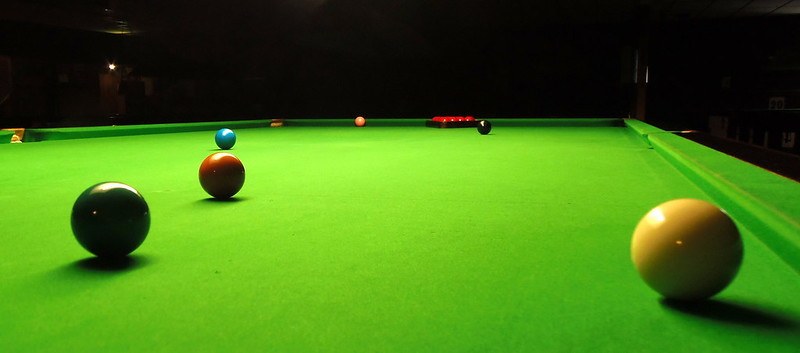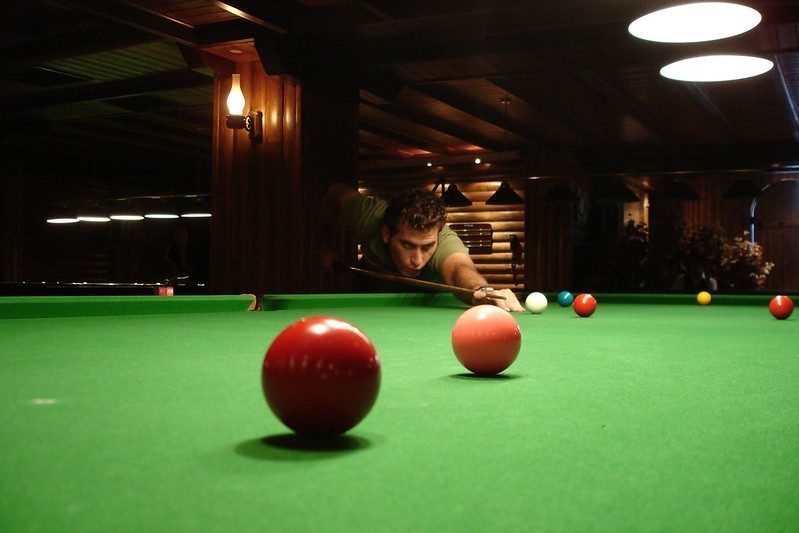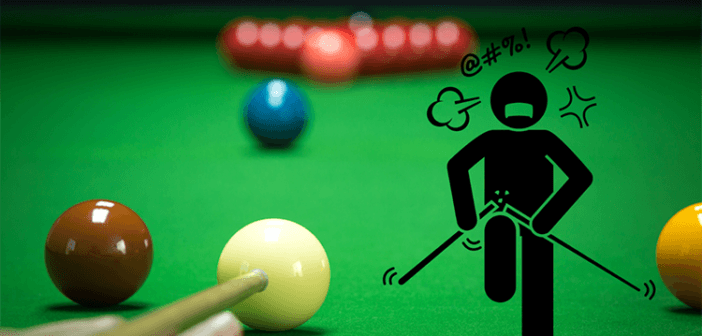What are some good snooker mental tips and routines?
Snooker, as we know, is played both on the table and inside your head.
It’s not enough to be technically proficient or a talented potter. Those who go on to enjoy the most success have a strong mental game that can look imperious to the casual observer.
So the question is…
What goes in to a successful snooker mindset?
Here are some tips and routines that may help.
Learn to Breathe Correctly
One of the reasons we play so much better in practice than in matches is because — obviously — the pressure is off.
Why does that matter? Why is performance affected by pressure?
Performance anxiety exists in every sport, but it is particularly destructive in a game like snooker which requires a coordinated response from so many muscles with such a tiny margin between success and failure.
A flinch here, a twitch there…
We’ve all seen the negative effects.
When we feel pressure, we tense up. Breathing becomes shallow and oxygen levels in the blood decrease. This affects your brain (your decision making) and the very muscles that you’re relying on to execute what under relaxed circumstances might seem like an easy shot.
Learning to breathe correctly under pressure is thus a huge advantage.
It’s beyond the scope of this article to explain how to truly breathe effectively, but there are several popular techniques such as diaphragmatic breathing, focused 4-7-8, or 7-11 breathing.
The wait while your opponent is at the table is a good opportunity to focus on your breathing. It’s also a good idea to create a mental hook or trigger that reminds you to take a deep breath before starting your shot routine.
For example, every time you chalk your cue, use that as the trigger to take a deep breath.
It’s common to see club players — very talented players — rushing through their shots and making mistakes in pressure situations. Often it is accompanied by the underlying need to “get the shot done with” as quickly as possible. This is a natural response if you are starving your body of oxygen through short shallow breathing.
Shallow breathing is often learned from an early age and it can be remarkably difficult to break the habit.
Be patient with yourself.
In your next match, if you can ‘catch yourself’ just once or twice and spot the gremlin, that’s progress.
Plan On Your Feet
How often do you get down on a shot and think, “Hmm, that doesn’t look quite right. Bit more to the left, I reckon. Probably need some extra oomph, too, to get out for the black.”

It’s hard to plan a shot from this view! Image Creative Commons via David_pics.
If you are planning your shot whilst down on the shot, newsflash:
The shot is likely to go tits-up.
You’ve already shanked it, mate.
Yes, we’ve all been there.
So many common snooker mistakes can be cut out of your game by swallowing an extra 5 seconds on your average shot time and planning thoroughly.
That means:
- Deciding on the correct line (and committing to it)
- The correct pace (try to settle on 10% power, 20%, 60%, etc)
- The correct spin
- Where you want the cue ball to land
There are generally two reasons why we skip this process:
1. In practice: because we’ve gotten lazy and fallen in to the habit of comfort-hitting the balls without sparing a second thought for where they go.
2. In matches: because we’re rushing, or too busy projecting thoughts on to the outcome of the shot. (“If I get this, I’ll be on for a 50”) or (“If I miss this, it’s frame over, John will be gloating, won’t hear the end of it. I’ll feel like shit in the morning. Won’t be able to sleep. Will look bloody stupid to the juniors over on Table 4.”)
In either case, we try to cut corners with the planning of our shots and then wonder why we’re suddenly out of position or plucking the cue ball out of the middle bag.
The reality is that planning every shot can become super tedious, especially in a practice session. And especially if you are not very good.
For the professionals it is less taxing.
They have already committed thousands of hours of deep learning to their subconscious to reach a point where the brain is fine-tuned to see the angles like a video game, the correct pace, the end position of the cue ball. That’s why they’re contesting the World Championships. The planning time is reduced to the point where if you watch Ronnie play, it’s like trespassing on genius.
We don’t have the same time to spare, so if you want to see a decent improvement, this next point is a game changer:
Stay Down On The Shot
How do you know if your cunning plan was a success?
“Well, I’ll hear the pot sink and I’ll see John’s face drop.”
This is the reality for most club players.
The ball is either in, or it isn’t. As soon as we’ve walloped that cue ball towards the target, we’re up like meerkats waiting for the verdict from the snooker gods. “AM I ON THE BROWN, JOHN?”

Snooker practice drill, image Creative Commons via M Rasoulov on Flickr
There is a clear and obvious correlation between movement on the shot and being any good at snooker.
Once you strike the cue ball, your eyes need to be tracking exactly what happens whilst you stay down on the shot.
This process fuels the deep learning that will allow your brain to make adjustments in the future.
To be more precise: you are comparing what you thought would happen vs. what actually happened.
A snooker player of any ability can do this. It is not a god given talent or a sign of genius. It is simply the fixed process that allows feedback from which you can make changes and improve as a player.
It’s okay to miss a sitter if you stay down and actually see the miss.
Most players don’t.
They only feel the miss.
The burning embarrassment, the jawed buggery of a promising break, the frothing anger at loudmouth Bob for staggering in to the line of the shot on his sixth pint. None of these primal reactions will teach you anything about how to play the shot if you face it again.
Learn to see instead of feel.
Practice With Intent
Try to set a target for every practice session.
The best way to do this is to adopt a variety of routines covering each aspect of the game, and then choose to focus on a couple of them per session.
Note: If you’re looking for routines, have a look at 147 Snooker Drills and Exercises by Andrew Highfield and David Horrix.
The majority of club players do not have many hours to practice, or tables at home, so it’s important to use the time wisely.
That means resisting the urge to comfort-hit balls out of boredom, and stick to targeted routines aimed at improving potting, break building, safety, cue ball control, etc.
It’s easier to stick to practice routines when they have a competitive element, so a scoring system is a great way to keep yourself engaged. It’s also a great way to track progress (see journalling below).
Nobody wants to practice long straight blues on repeat in their lunch break, but a tightly controlled exercise of 10 attempts with a conversion target (30%, 40%, etc) will help to keep you focused.
Of course, the game is supposed to be fun — not just hard graft.
By all means include an open table element to your practice. It’s fine to smack balls around as a distraction from the stresses in life if that’s what your hobby calls for. But if there is a part of your game that is letting you down in matches, and you want to improve it, then practicing with intent is essential.
Head in to the club with a clear plan of what you’re going to work on.
Save the trick shots until you’ve worked the plan.
Keep a Journal or Record of Progress

Are you keeping track of your progress? Image Creative Commons by Jeni Enjaian
What good is a journal for a successful snooker mindset?
Is it really necessary to keep a record of what went well, what went badly, and things to improve?
Well it certainly doesn’t hurt.
Think of it as a de-briefing with the coach.
Snooker is such a technical game that it can be difficult to extract the benefit out of a tweak here or there in the time that slips away between sessions.
How many times do you leave the club feeling fantastic having discovered that X, Y or Z works well — only to find the effect impossible to replicate when you next pick up a cue?
Well, bad news! This is still a pain in the arse, whether you keep a journal or not.
However, by keeping track of your sessions and writing down observations, you’ll build a much firmer understanding of your game. You’ll detect patterns and recurring problems that can be isolated to work on.
“So… I smashed the pack open, conceded, snapped my cue in half and called an Uber. Next time I should play darts.”
Don’t just journal your thoughts and observations
Keep a scorecard for your practice routines.
Daily performance will vary naturally, but with the right routines in place you should see a marked improvement for each exercise when the scores are tallied in to a rolling monthly average.
But isn’t a journal a bit fancy for a club player?
We’re not talking Moleskines and quills here.
All you need is a piece of paper, an index card or a simple text app on your phone. You can be as flash or as basic as you need to be. We’ve seen Excel spreadsheets and running graphs of routines by date practiced with columns of Best Breaks. We’ve also seen notes scribbled on fag packets.
The point is to get the point out of your head.
It’s particularly useful to keep a journal of your thoughts after each match.
At what points did you feel in control? Was there anything that felt ‘right’? Physically? In the setup? In the mental thought process?
How did the opponent affect your game? Did anything affect your concentration beyond the game itself?
What were the critical exchanges in each frame that decided the result?
Record these observations and take the time to reflect on them before your next event.
If you remember vividly the shot that cost you a frame and it’s tormenting your drive home, sketch the damn thing down and practice it in your next session.
A journal is not a magic bullet, but it is a useful method of confronting the key variables that can unlock further progress.
Accepting What Is
There’s a recurring theme here.
Many of the steps that go in to building mental strength for snooker are actually just small changes that bring us closer to the reality of what is happening on the table.
- Seeing mistakes instead of feeling them.
- Keeping track of results instead of basking or boiling in them.
- Focusing on the present instead of hyperventilating on the what-ifs.
- Staying in the moment.
Are you playing with your eyes open? Or sleepwalking around the table making the same mistakes over and over again?
Take a good look at your current game and ask: what are my blind spots?
Every player has weaknesses that he is aware of.
The difference between the great players and the club bangers is:
1. The great players actually work on their weaknesses. Methodically. With intent.
2. The great players are actively looking for more weaknesses to work on.
And that all starts by being honest with the results you are currently getting.
What are your snooker mental tips and routines?
Let us know in the comments below.
Liked this article? Feel free to share it with any club bangers who would appreciate the tips. 😉


9 Comments
A very good article, the only point I would make is that maybe weaknesses could be referred to as ‘oportunities for improvement’ 😉
Good point. I find the glass is either half full or completely empty depending on what the final score was and who I lost to. 😂
I have developed some form of the yips lately and wondering if any ideas about getting over them?
Fantastic article when you put it in the way you have done it makes good sense which I’ve never thought of just like that. Thanks very much Kev
Cheers Kev!
A great read and one I shall take note of and hopefully Introduce to my learners. ( young kids) in our kids club.
So true … very good Article … thanks … Martin
Played loads off leauge games sinse 1978 but still cannot get high breaks I seem to let myself down on the easy shots .🍺
Great read ill definitely be taking these points into my game thank you .